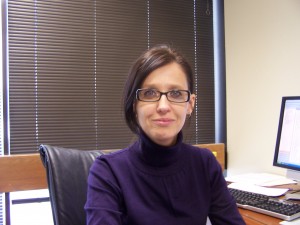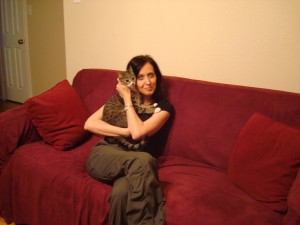 Dr. Mihaela C. Stefan is an Assistant Professor in the Department of Chemistry at University of Texas at Dallas. She received a BS in Chemical Engineering, and MS and Ph.D. degrees in Chemistry from Politehnica University Bucharest, Romania. She worked as a Postdoctoral Researcher in Krzysztof Matyjaszewski’s and Richard McCullough’s research groups at Carnegie Mellon University. She joined the Department of Chemistry at the University of Texas at Dallas in August 2007. Since 2007 she has attracted 9 graduate students, 31 undergraduate students, and 3 summer high school student into her research lab. Currently, 6 graduate students and 6 undergraduate students are working in her lab. She has published more than 40 peer-reviewed papers out of which 19 were published after joining UTD.
Dr. Mihaela C. Stefan is an Assistant Professor in the Department of Chemistry at University of Texas at Dallas. She received a BS in Chemical Engineering, and MS and Ph.D. degrees in Chemistry from Politehnica University Bucharest, Romania. She worked as a Postdoctoral Researcher in Krzysztof Matyjaszewski’s and Richard McCullough’s research groups at Carnegie Mellon University. She joined the Department of Chemistry at the University of Texas at Dallas in August 2007. Since 2007 she has attracted 9 graduate students, 31 undergraduate students, and 3 summer high school student into her research lab. Currently, 6 graduate students and 6 undergraduate students are working in her lab. She has published more than 40 peer-reviewed papers out of which 19 were published after joining UTD.
She received the NS&M Outstanding Teacher Award in 2009 and the Inclusive Teaching Diversity Award in 2012. She is aslo a recipient of the Faculty Early Career Development (CAREER) award from NSF, which is given to junior faculty who exemplify the role of teacher-scholars through outstanding research, excellent education and the integration of education and research. Her research group is developing novel polymeric materials for organic electronics and for drug delivery applications. The common theme on both research directions is the interdisciplinary training of students at the interface between organic/polymer chemistry and materials science.
For more information see here: http://www.utdallas.edu/~mci071000/
What was your inspiration in becoming a chemist?
My parents were chemists and I started to visit their labs when I was only 5-6 years old. At the initial stage I was fascinated with the colors in the lab as my mom used to show me titrations. Sometimes my mom would take me to work on Saturdays because she could not take me to the kindergarten on weekends. Going to work with my mom was so much better than going to kindergarten. When I had to decide for college I choose to study chemical engineering because traditionally back in my home country when you study chemistry you prepare for a teaching career. At that time teaching was something I would have not considered as a career choice. Now teaching is such an important part of my work and I can never imagine my life without going in the classroom to teach.
What was the motivation to write this review? (DOI: 10.1039/C1PY00453K)
I wrote the review as an invited paper for the themed issue on New Methods of Polymer Synthesis. The review describes the synthesis of block copolymers of polythiophene by Grignard metathesis (GRIM) polymerization. My group works on the development of novel semiconducting polymers for organic electronics applications. Whenever possible we use Grignard metathesis method because it is a living polymerization which allows the control of the molecular weights and functional end groups of the semiconducting polymers.
Why did you choose Polymer Chemistry to publish your work?
Polymer Chemistry is one of the leading journals in polymer science. This is my second paper to be published in Polymer Chemistry and both times I enjoyed the fast time to publication and the fair review process.
In which upcoming conferences may our readers meet you?
I will attend the International Conference on Science and Technology of Synthetic Metals ICSM 2012 which will be held on July 8-13 in Atlanta. I will also give an invited talk to the “Young Academic Investigators” Symposia organized by the Organic Division of ACS at the Fall 2012 ACS Meeting in Philadelphia.
How do you spend your spare times?
I do not have much spare time because we are trying to work hard to build a successful research group. However, when I have time to take a break from my work I like to read biographies. I love reading biographies of scientists and I always look to buy books. I also enjoy playing with my cats. In the future I hope to find some spare time to volunteer for a shelter as I love animals, especially cats.
Which profession would you choose if you were not a scientist?
I would probably have pursued a career as a cat veterinarian if I was not a scientist.











